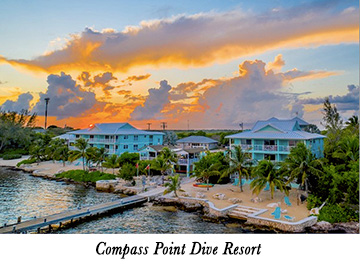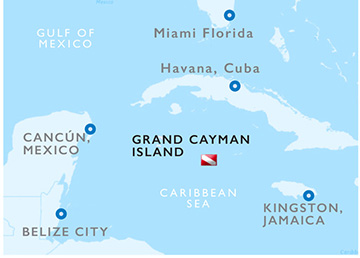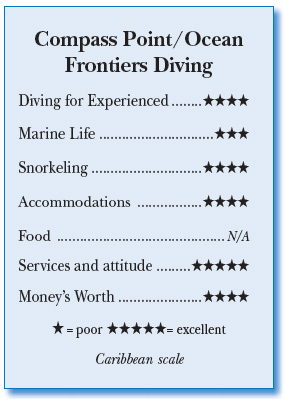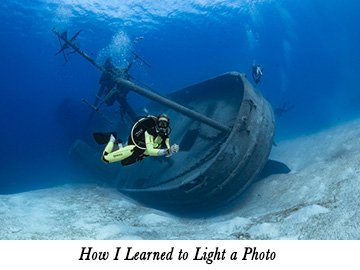Compass Point, Ocean Frontiers, Grand CaymanContents of this Issue: Compass Point, Ocean Frontiers, Grand Cayman Is an Alex Mustard Workshop Right for You? Want to Enroll in an Underwater Photography Course? The Caribbean, Hawaii, the Galapagos, Florida Your Reader Reports are Important Florida Goliath Grouper Protection Battle Lost Do Great Whites Mate off the Carolinas? Save a Reef? Weed it Like You’d Weed a Garden Yucatan Cenotes in Danger of Destruction The Lionfish’s Fear of Being Eaten Lego Reveals the Longevity of Plastic in the Ocean Cancun Dive Boat Propellers Kill Two American Divers Editorial Office: Ben Davison Publisher and Editor Undercurrent 3020 Bridgeway, Suite 102 Sausalito, CA 94965 plenty of Mustard at the underwater from the March, 2022 issue of Undercurrent
Dear Fellow Diver, I began the year 2021 by jumping into the water off Cozumel and destroying my Panasonic LUMIX LX-10 camera because the housing was open. I shed some tears -- I hate that kind of pricey mistake. But perhaps it was time to step up to a mirrorless camera, a Nikon Z6ii, with all the accoutrements. In making the investment, I realized I had hit a wall with my underwater photography. It was time for some expert help.
On Cayman's East End, Compass Point is a true diver's resort, with its one-, two-, and three-bedroom apartments just a few steps from the dive dock. I scored a first-floor room on the sand with beach chairs right off my patio. The room itself was of Hampton Inn quality -- perfectly serviceable and comfortable, quite a bit more sizeable than expected, and included a kitchenette with a full-sized refrigerator, a microwave, and a dishwasher. I left my gear outside my front door, and the staff had it set up on the boat the next morning. Saturday at 7 p.m., I joined 12 other eager photographers. Most were Alex's repeat customers and had come long way -- the UK, Argentina, and Australia, besides the U.S. -- to study at the fins of the master. Alex, an affable guy, gave us a course overview and plans for the first day. He's the kind of person you want on your dive trips. Friendly, approachable, unflappable, an overall good egg. I already knew it would be a fine week. The first morning, after Alex and our guide discussed the sites' highlights and photographic opportunities, we dived both Babylon and McCurley's Wall to practice close-focus wide-angle lighting of sponge and reef formations. I knew the Cayman Islands were having trouble with Stony Coral Tissue Loss Disease (SCTLD), and indeed I saw devastation. I was pleased to see healthy elkhorn corals and several pristine star coral formations. But 80 percent of the reef seemed like rubble. Not all of this is due solely to SCTLD, but there is indeed a lot of dead rock. But there is good news. Guide Samantha Lungari is active in an island-wide program controlling SCTLD by applying an amoxicillin paste to deteriorating coral. She reports there is an excellent success in halting the spread. And, I did see some lovely rope, tube, and icing sponge formations, as well as small strawberry vase sponges, impressive elephant ear sponges, and sea rods. As for broken gorgonians, Alex said he liked how the fans branched and cracked off those less than perfect -- to him, the perfect sea fan had become a boring photography subject. His glass was always half-full. Widely regarded as one of the world's leading underwater photographers, Alex holds a Ph.D. in marine biology. He boosted my confidence after dive one by checking my colors and lighting and giving me tips to pull back my strobes to diffuse the light to make my colors less "hot."
While diving, we could either pair with a buddy or stick near the group, so I parked myself in one spot to shoot subjects and think about the adjustments I needed to get the shot right. And then tried again (and again and again) until I was satisfied. Alex suggested jump settings (F-stop, ISO, shutter speed) for each dive and discussed proper strobe positioning. Having all the time I wanted to work through his instructions meant I could relax knowing I wasn't holding up a buddy. The guides, without interrupting us, circled around to ensure we were paying attention to tank pressure and, if asked, modeled for our shots. At Ironshore, a dive site with a maze of tight swim-thrus, I experimented with a technique Alex had covered the night before (increasing ISO while decreasing shutter speed makes the most of the light outside the cave while framing the scene with a silhouette of the caves' craggy formations). Alex said that lighting both inside and outside the cave often made a photo appear harshly lit. Sure enough, my ambient-light-only images were far more pleasing than those I took with strobes.
Our 46-foot Newton dive boat had two double-decker camera tables, providing more than enough room to stow our 16 full-sized rigs. And the Ocean Frontiers staff was first-rate. If you're there on your own, you'll get plenty of good attention. When Captain Jon Barron heard I had a warped bayonet mount on my dome port (though he already had his dive gear on), he was more enthusiastic about working on the camera than going diving. Earlier in the trip, my vacuum sensor started flashing. He swam my camera back to the boat and figured out that I had given my vacuum a little too much pumping. When my guide Sam heard I wanted to work on my backward kick, she made it her business to get me squared away. Sam and Jon also hauled my gear to the swim step before dives and afterward hauled it out of the water. Because this was a workshop, food was fuel, not entertainment. We had little time for lunches, we were encouraged to buy groceries to prepare something and eat quickly. Since the standard package at Compass Point includes a rental car, it was simple to get something down the street. Nearby restaurants took phone orders and delivered dinners quickly. While I did not eat at Compass Point's restaurant (Eagle Ray's) it generally gets good reviews, and its small outdoor bar is a fun place for bar food and drinks. In pursuit of food and unaccustomed to driving on the left with a steering wheel on the right in an unfamiliar Suzuki, I managed to dent my front bumper on a low rock wall. My travel insurance with Divers Alert Network via Generali covered the $344 damage.
To shoot larger creatures, we took a dawn trip to Stingray City to take over-under shots of the stingrays and the sunrise. At Jack McKenney's Canyons, a beautiful school of reef sharks swam with us. Because the Caymans required supervised rapid COVID tests on days two, five, and seven following arrival on the island, Ocean Frontiers scheduled our dives to accommodate the tests. And, they had plenty of rapid tests we could use on our own, gratis, which proved fortunate. You see, on Thursday, Alex tested positive and had to go into a mandatory seven-day quarantine in his room at Compass Point! While some folks masked for the first days, when everyone tested negative on day two, most of us (including me) dropped the masks, clearly a mistake.
I did have one disappointment with the workshop, in that Alex did not offer in-water assistance and instruction, but instead pursued his own photography. At one point, I was stuck trying to figure out how to fix a red color cast. (A friend later told me he laughed when he saw me back away from my subject and hang in the water while drumming my thumbs against my housing.) I took a full 19 minutes of that dive trying (unsuccessfully) to solve my problem. I sure could have used a few moments of help from Alex. (I saw red and thought "hot," so I kept trying to turn the lighting down, but the answer turned out to be the opposite: I needed more light.) A friend said, "Imagine being in a painting class and having the teacher off painting in a corner rather than coming by each student and offering advice." But when it comes to diving, it seems that's the deal with photography workshops with a pro; underwater, you're on your own. Recognizing that, I'll sure return for another workshop or two with him. Like the rest of his return customers, I'd gain a lot by spending more classroom time with him. But I'd better sign up as soon as he announces his next workshop. Because so many of his students come back for more, one has to act quickly to get into a class offered by this excellent teacher and all-around good bloke. -- E.T.S. Author's Bio: The grandmother of an 8-month-old, she is counting the days until they take Bubblemaker together. She began diving in 2000 and completed her divemaster certification for funsies in 2017. She's split her diving time among the Hawaiian Islands, the Caribbean, and Indonesia. Last fall, she went shore diving off Long Island and recommends coming yourself to check out the New York attitude of the local Lady Crab/Calico Crab/Ovalipes Ocellatus population.
|

I want to get all the stories! Tell me how I can become an Undercurrent Online Member and get online access to all the articles of Undercurrent as well as thousands of first hand reports on dive operations world-wide
| Home | Online Members Area | My Account |
Login
|
Join
|
| Travel Index |
Dive Resort & Liveaboard Reviews
|
Featured Reports
|
Recent
Issues
|
Back Issues
|
|
Dive Gear
Index
|
Health/Safety Index
|
Environment & Misc.
Index
|
Seasonal Planner
|
Blogs
|
Free Articles
|
Book Picks
|
News
|
|
Special Offers
|
RSS
|
FAQ
|
About Us
|
Contact Us
|
Links
|
3020 Bridgeway, Ste 102, Sausalito, Ca 94965
All rights reserved.

 As COVID kept most divers home, Alex Mustard, who wrote the excellent book Underwater Photography Master Class, started teaching online underwater photography seminars (
As COVID kept most divers home, Alex Mustard, who wrote the excellent book Underwater Photography Master Class, started teaching online underwater photography seminars ( One of my goals was to get my images correct
when I shot them rather than relying afterward on editing or cropping. During his
nightly seminars, he taught lighting methods that allowed for an even, pleasing
wash of lighting with appropriate penetration into the scene. He covered advanced
techniques, such as inward lighting (strobes pointed toward the photographer's
head) to achieve a wash of light on only the foremost subject. He ran a swimming
pool exercise to help each of us zero in on proper close focus wide angle lighting,
while ensuring that each of us understood how to use aperture, ISO, and shutter
speed together. Alex fielded our questions, reviewed our work, and encouraged
us to weigh in on each other's work. With his excellent feedback, we all knew what
we needed to work on. For me, it was giving thought to the background to maximize
depth.
One of my goals was to get my images correct
when I shot them rather than relying afterward on editing or cropping. During his
nightly seminars, he taught lighting methods that allowed for an even, pleasing
wash of lighting with appropriate penetration into the scene. He covered advanced
techniques, such as inward lighting (strobes pointed toward the photographer's
head) to achieve a wash of light on only the foremost subject. He ran a swimming
pool exercise to help each of us zero in on proper close focus wide angle lighting,
while ensuring that each of us understood how to use aperture, ISO, and shutter
speed together. Alex fielded our questions, reviewed our work, and encouraged
us to weigh in on each other's work. With his excellent feedback, we all knew what
we needed to work on. For me, it was giving thought to the background to maximize
depth. While most often the visibility ran 80 feet or so, but we had some uncooperative weather, so one day, we switched to our macro lenses at Sunset Reef East, where our guide pointed out plenty of beautiful golden rough-head blennies that were accustomed to divers and raised far out of their holes. A cooperative squirrelfish stuck around me, so I took every possible shot I wanted. I got some quality time with feather dusters, nice schools of French grunts, schoolmasters, and colorful anemones. Since the dive was so shallow, I spent 90 minutes at the site, not at all a problem in the 81-degree water, but by now I was in a 5 mm suite with a hooded vest. While I had started with a 3 mm suit and hooded vest, after several dives the water felt much colder.
While most often the visibility ran 80 feet or so, but we had some uncooperative weather, so one day, we switched to our macro lenses at Sunset Reef East, where our guide pointed out plenty of beautiful golden rough-head blennies that were accustomed to divers and raised far out of their holes. A cooperative squirrelfish stuck around me, so I took every possible shot I wanted. I got some quality time with feather dusters, nice schools of French grunts, schoolmasters, and colorful anemones. Since the dive was so shallow, I spent 90 minutes at the site, not at all a problem in the 81-degree water, but by now I was in a 5 mm suite with a hooded vest. While I had started with a 3 mm suit and hooded vest, after several dives the water felt much colder. The USS Kittiwake, a submarine rescue vessel purposely sunk in 2011 in 60 feet of water, is a diving playground with plenty of external passages and ship features that even new divers can explore. The structure got my photo composition juices flowing. A friendly green turtle stuck around one of our divers, providing excellent photo opportunities -- even swimming through a hole while positioned against the camera dome. For this dive, Alex suggested we use his "Magic Filters," red filters he designed and sells. They allow for color correction penetration far beyond the distance strobes can reach, allowing photographers to get colorful wide-angle photos of the entire wreck. Two guides, Sam and Candace, modeled for us, providing interest and perspective for our photos.
The USS Kittiwake, a submarine rescue vessel purposely sunk in 2011 in 60 feet of water, is a diving playground with plenty of external passages and ship features that even new divers can explore. The structure got my photo composition juices flowing. A friendly green turtle stuck around one of our divers, providing excellent photo opportunities -- even swimming through a hole while positioned against the camera dome. For this dive, Alex suggested we use his "Magic Filters," red filters he designed and sells. They allow for color correction penetration far beyond the distance strobes can reach, allowing photographers to get colorful wide-angle photos of the entire wreck. Two guides, Sam and Candace, modeled for us, providing interest and perspective for our photos. Steve Broadbelt, the Compass Point Managing Director, and Alex quickly adjusted plans. We had been in an outdoor classroom all week, so they moved the video screen and projector and set up a microphone and speaker at Alex's room. We sat outside, our masks back on, 18 feet away from Alex's closed sliding glass doors. From inside his room, he reviewed our photos on the outdoor screen and provided critiques and further teaching. Alex appeared via Zoom on the boat for the final two dives on Friday, giving pre-dive briefings on the sites and their photographic opportunities. Besides Alex, two other divers got COVID, and only one was symptomatic (though mild, thankfully). Both had to extend quarantine for seven days, disrupting further diving and travel plans, at an additional expense. The Cayman Islands have since relaxed their COVID precautions.
Steve Broadbelt, the Compass Point Managing Director, and Alex quickly adjusted plans. We had been in an outdoor classroom all week, so they moved the video screen and projector and set up a microphone and speaker at Alex's room. We sat outside, our masks back on, 18 feet away from Alex's closed sliding glass doors. From inside his room, he reviewed our photos on the outdoor screen and provided critiques and further teaching. Alex appeared via Zoom on the boat for the final two dives on Friday, giving pre-dive briefings on the sites and their photographic opportunities. Besides Alex, two other divers got COVID, and only one was symptomatic (though mild, thankfully). Both had to extend quarantine for seven days, disrupting further diving and travel plans, at an additional expense. The Cayman Islands have since relaxed their COVID precautions. Divers Compass: Max of 14 students for the photography workshop . . . 17 dives offered . . . seven-night workshop price starts at $3270/person double occupancy, taxes, Nitrox included . . . free Wi-Fi . . . price includes a rental car for the entire stay . . Trash and recycling were removed daily. Room service was optional for an extra $20/day for a basic cleaning or $40/day for full service . . . All fees, including tips, can be paid via credit card . . . must apply to Travel Cayman portal for an official Certificate to Travel . . . must be fully vaccinated. Go to this website to order Underwater Photography Master Class
Divers Compass: Max of 14 students for the photography workshop . . . 17 dives offered . . . seven-night workshop price starts at $3270/person double occupancy, taxes, Nitrox included . . . free Wi-Fi . . . price includes a rental car for the entire stay . . Trash and recycling were removed daily. Room service was optional for an extra $20/day for a basic cleaning or $40/day for full service . . . All fees, including tips, can be paid via credit card . . . must apply to Travel Cayman portal for an official Certificate to Travel . . . must be fully vaccinated. Go to this website to order Underwater Photography Master Class 